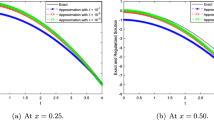Abstract
In this paper, we study the stabilization and the partial exact controllability of an inhomogeneous multidimensional thermoelastic diffusion problem by a memory function introduced on a part of the boundary of the material. By using the Nakao difference inequality, we prove that the energy of the system decays to zero exponentially at a rate determined explicitly by the physical parameters. Then by the Hilbert uniqueness method combined with Russell’s principle “controllability via stabilizability,” we prove that after certain threshold time moment, the considered system is partially controllable under a smallness restriction on the coupling parameters stress-temperature and stress-diffusion. The boundary control function is determined explicitly.
Similar content being viewed by others
References
R. Adams, Sobolev Spaces, Academic Press, New York (1975).
M. Aouadi, “Generalized theory of thermoelstic diffusion for anisotropic media,” J. Therm. Stresses, 31, 270–285 (2008).
M. Aouadi and K. Boulehmi, “Partial exact controllability for inhomogeneous multidimensional thermoelastic diffusion problem,” J. Evol. Equat. Control Theory, 5, 201–224 (2016).
M. Aouadi, B. Lazzari, and R. Nibbi, “Exponential decay in thermoelastic materials with voids and dissipative boundary without thermal dissipation,” Z. Angew. Math. Phys., 63, 961–973 (2012).
M. Aouadi, B. Lazzari, and R. Nibbi, “Energy decay in thermoelastic diffusion theory with second sound and dissipative boundary,” Mecanica, 48, 2159–2171 (2013).
R. F. Apolaya, “Exact controllability for temporally wave equation,” Portug. Math., 51, 475–488 (1994).
P. Barral and P. Quintela, “A numerical method for simulation of thermal stresses during casting of aluminium slabs,” Comput. Methods Appl. Mech. Eng., 178, 69–88 (1998).
A. Bermudez, M. C. Muñoz, and P. Quintela, “Numerical solution of a three-dimensional thermoelectric problem taking place in an aluminum electrolytic cell,” Comput. Methods Appl. Mech. Eng., 106, 129–142 (1993).
K. Boulehmi and M. Aouadi, “Decay of solutions in inhomogeneous thermoelastic diffusion bars,” Appl. Anal., 93, 281–304 (2014).
C. M. Dafermos, “On the existance and the asymptotic stability of solution to the equations of linear thermoelasticity,” Arch. Rat. Mech. Anal., 29, 241–271 (1968).
L. De Teresa and E. Zuazua, “Controllability of the linear system of thermoelastic plates,” Adv. Differ. Equations, 1, 369–402 (1996).
H. Gao and J. E. Muñoz Rivera, “On the exponential stability of thermoelastic problem with memory,” Appl. Anal., 78, 379–403 (2001).
S.W. Hansen, “Boundary control of a one-dimensional linear thermoelastic rod,” SIAM J. Control Optim., 32, 1054–1074 (1994).
V. Komornick and E. Zuazua, “A direct method for boundary stabilisation of the wave equation,” J. Math. Pures Appl., 69, 33–54 (1990).
I. Lasiecka, Mathematical Control Theory of Coupled PDEs, SIAM, Philadelphia (2002).
G. Lebeau and E. Zuazua, “Sur la décroissance non uniforme de l’énergie dans le système de la thermoélasticité linéaire,” C. R. Acad. Sci. Paris. Ser. I. Math., 324, 409–415 (1997).
G. Lebeau and E. Zuazua, “Null controllability of a system of linear thermoelasticity,” Arch. Rat. Mech. Anal., 141, 297–329 (1998).
J. L. Lions, Contȏlabilité Exacte Perturbations et Stabilisations des Systèmes Distribués. Tome 2. Pertubations, Masson, Paris (1988).
J. L. Lions and E. Magenes, Nonhomogeneous Boundary Value Problem and Applications, Springer-Verlag (1972).
W. J. Liu, “Partial exact controllability and exponential stability in higher-dimensional linear thermoelasticity,” ESAIM: Control Optim. Calc. Var., 3, 23–48 (1998).
W. J. Liu, “Partial exact controllability and exponential stability in higher-dimensional linear thermoelasticity. Correction,” ESAIM: Control Optim. Calc. Var., 3, 323–327 (1998).
W. J. Liu and G. H. Williams, “Partial exact controllability for the linear thermo-viscoelastic model,” Electr. J. Differ. Equations, 1998, 1–11 (1998).
W. J. Liu and E. Zuazua, “Uniform stabilization of higher-dimensional system of thermoelasticity with a nonlinear boundary feedback,” Quart. Appl. Math., 59, 269–314 (2001).
J. E. Muñoz Rivera and M. L. Olivera, “Stability in inhomogeneous and anisotropic thermoelasticity,” Boll. U.M.I., 7, 115–127 (1997).
M. Nakao, “A difference inequality and its application to nonlinear evolution equations,” J. Math. Soc. Jpn., 30, 291–315 (1978).
A. K. Nandakumaran and R. K. George, “Partial exact controllability of linear thermoelastic system,” Indian J. Math., 37, 165–174 (1995).
K. Narukawa, “Boundary value control of thermoelastic systems,” Hiroshima Math. J., 13, 227–272 (1983).
J. A. Nohel and D. F. Shea, “Frequency domain methods for Volterra equations,” Adv. Math., 22, 278–304 (1976).
J. Prüss, Evolutionary Integral Equations and Applications, Birkhäuser, Basel (1993).
G. Propst and J. Prüss, “On wave equations with boundary dissipation of memory type,” J. Integral Equations Appl., 8, 99–123 (1996).
D. L. Russell, “Controllability and stabilizability theory for linear partial differential equations,” Recent Progr. Open Questions SIAM Rew., 310, 801–806 (1990).
O. J. Staffans, “An inequality for positive definite Volterra kernels,” Proc. Am. Math. Soc., 58, 205–210 (1976).
O. J. Staffans, “On a nonlinear hyperbolic Volterra equation,” SIAM J. Math. Anal., 11, 793–812 (1980).
E. Zuazua, “Controllability of the linear system of thermoelasticity,” J. Math. Pure. Appl., 74, 303–346 (1995).
Author information
Authors and Affiliations
Corresponding author
Additional information
Translated from Itogi Nauki i Tekhniki, Seriya Sovremennaya Matematika i Ee Prilozheniya. Tematicheskie Obzory, Vol. 178, Optimal Control, 2020.
Rights and permissions
Springer Nature or its licensor (e.g. a society or other partner) holds exclusive rights to this article under a publishing agreement with the author(s) or other rightsholder(s); author self-archiving of the accepted manuscript version of this article is solely governed by the terms of such publishing agreement and applicable law.
About this article
Cite this article
Aouadi, M., Boulehmi, K. Boundary Controllability for Inhomogeneous Multidimensional Thermoelastic Diffusion Problem by Hilbert’s Uniqueness Method. J Math Sci 276, 253–273 (2023). https://doi.org/10.1007/s10958-023-06739-w
Published:
Issue Date:
DOI: https://doi.org/10.1007/s10958-023-06739-w



